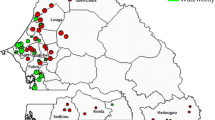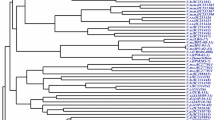Abstract
Diversity in 20 microsatellite loci of wild emmer wheat, Triticum dicoccoides, was examined in 15 populations (135 genotypes) representing a wide range of ecological conditions of soil, temperature, and water availability, in Israel and Turkey. An extensive amount of diversity at microsatellite loci was observed despite the predominantly selfing nature of this plant species. The 20 Gatersleben wheat microsatellites (GWM), representing 13 chromosomes of genomes A and B of wheat, revealed a total of 364 alleles, with an average of 18 alleles per GWM marker (range: 5–26). The proportion of polymorphic loci per population averaged 0.90 (range: 0.45– 1.00); genic diversity, He, averaged 0.50 (range 0.094– 0.736); and Shannon’s information index averaged 0.84 (range 0.166–1.307). The coefficients of genetic distance between populations were high and averaged D=1.862 (range 0.876–3.320), an indication of sharp genetic divergence over short distances. Interpopulation genetic distances showed no association with geographic distance between the population sites of origin, which ruled out a simple isolation by distance model. Genetic dissimilarity values between genotypes were used to produce a dendrogram of the relationships among wild wheat populations by the unweighted pair-group method with arithmetic averages (UPGMA). The results showed that all the wild emmer wheat populations could be distinguished. Microsatellite analysis was found to be highly effective in distinguishing genotypes of T. dicoccoides, originating from diverse ecogeographical sites in Israel and Turkey, with 88% of the 135 genotypes correctly classified into sites of origin by discriminant analysis. Our present microsatellite results are non-random and in agreement with the previously obtained allozyme and RAPD patterns, although the genetic-diversity values obtained with microsatellites are much higher. Significant correlates of microsatellite markers with various climatic and soil factors suggest that, as in allozymes and RAPDs, natural selection causes adaptive microsatellite ecogeographical differentiation, not only in coding, but most importantly in non-coding genomic regions. Hence, the concept of ”junk DNA” needs to be replaced by at least partly regulatory DNA. The obtained results suggest that microsatellite markers are useful for the estimation of genetic diversity in natural populations of T. dicoccoides and for the tagging of agronomically important traits derived from wild emmer wheat.
Similar content being viewed by others
Author information
Authors and Affiliations
Additional information
Received: 27 February 2001 / Accepted: 22 March 2001
Rights and permissions
About this article
Cite this article
Fahima, T., Röder, M., Wendehake, K. et al. Microsatellite polymorphism in natural populations of wild emmer wheat, Triticum dicoccoides, in Israel. Theor Appl Genet 104, 17–29 (2002). https://doi.org/10.1007/s001220200002
Issue Date:
DOI: https://doi.org/10.1007/s001220200002




